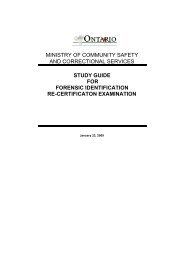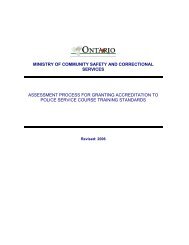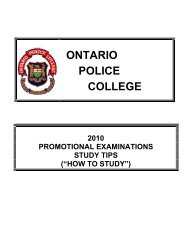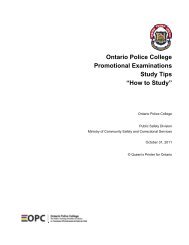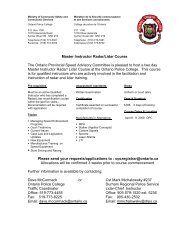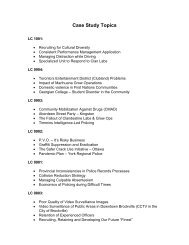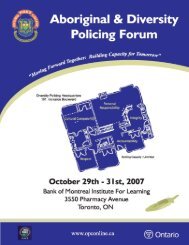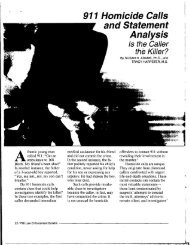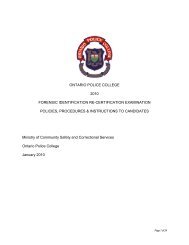General Study Guide - Ontario Police College
General Study Guide - Ontario Police College
General Study Guide - Ontario Police College
Create successful ePaper yourself
Turn your PDF publications into a flip-book with our unique Google optimized e-Paper software.
Friction Skin - Dermal Papillae<br />
The boundary between the dermis and epidermis is a point<br />
of potential weakness where the two tissues may be<br />
separated from each other. The fingerlike formations (or<br />
interdigitation) also serve to strengthen the<br />
epidermis/dermis junction.<br />
As one ages the dermal papillae tend to flatten and may<br />
increase in numbers. In this situation, each papilla appears<br />
to develop into a group...staying at the same overall size but<br />
individually much smaller.<br />
Sweat Glands<br />
Sweat glands, or eccrine glands, are found over the<br />
entire surface of the body except a few small areas.<br />
They are most concentrated in the palms and soles of the<br />
feet. The eccrine sweat glands in this skin section are<br />
well developed, and their ducts (dark staining in image)<br />
can be distinguished from the lighter staining secretory<br />
portions.<br />
They are simple coiled tubular glands; they consist of a<br />
highly coiled secretory portion deep in the dermis, and a<br />
relatively straight duct conducts the secretions toward<br />
the surface of the epidermis. Each duct opens in the<br />
centre of the ridge "unit" (cristae cutis).<br />
Eccrine sweat contains approximately 99% water and<br />
1% solids. The solids are half inorganic salt (mostly<br />
sodium chloride) and organic compounds (amino acids,<br />
urea and peptides).<br />
Other types of Secretory Glands (not found on Volar<br />
surfaces but may contaminate fingerprint residue or<br />
matrix) include sebaceous (oily secretions emptied into<br />
hair follicles) and apocrine secretions from specific<br />
sweat glands on the body.<br />
Incipient Ridges - An ‘immature’ friction ridge that is not fully developed. They may appear shorter and<br />
thinner in appearance than fully developed friction ridges. These ridges are also called interstitial, nascent,<br />
rudimentary and subsidiary ridges. They may or may not have fully developed pore formations.<br />
Friction Ridge Imbrication - Imbrication is observed on some areas of the volar surface where the friction<br />
ridges all tend to lean in the same direction. Friction skin is very flexible. This feature enhances the ability of<br />
the friction ridges to grip surfaces. When the friction ridges roll before slippage, this is also referred to as<br />
imbrication.



